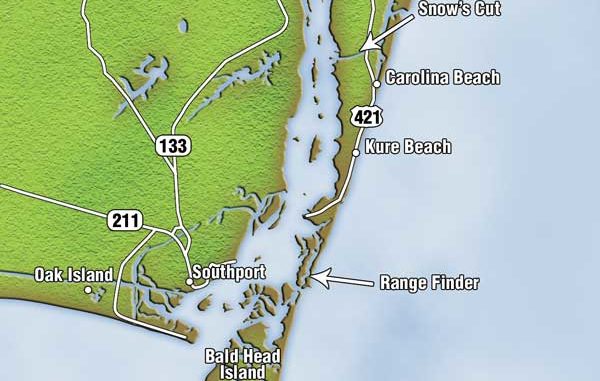
Anglers have to be quick on the draw to catch ‘convict’ fish.
Fishing partners Lewis Emery and Larry Essick of Wilmington enjoy chasing a couple of species that are plentiful in their area, but they often take a break from red drum and sea trout to challenge sheepshead.
What probably whets their appetite is seeing small to magnum sheepshead in the same areas they fish for reds and specks. Then there’s the challenge — few people actually target sheepshead, because to do so successfully takes patience and skill.
The old bromide that in order to catch a sheepshead an angler must set the hook “just before he bites” isn’t totally true, but it’s not far from accurate.
“I got interested in sheepshead fishing when I was fishing for speckled trout at the rock wall south of the Fort Fisher boat ramp,” said Emery, who runs Tails Up Charters and works at Carolina Beach’s Island Hardware & Tackle. “I’d put my boat in at the Fort Fisher access, then fish the incoming tide along the rocks. Early in the morning is the best time to fish for topwater specks, but I kept seeing sheepshead there, too.”
The U.S. Army Corps of Engineers built the rock wall in the 1890s to prevent sand from now-closed Corncake Inlet from filling in the Cape Fear River channel and making navigation for large boats difficult. The rock wall now protects what locals call “First Bay” (properly known as “The Basin”) and two other bays: Second and Buzzard’s. Zeke’s Island, No Name Island and North Island also are protected behind the rock wall.
While trout fishing, Emery used the trolling motor on the bow of his Carolina Skiff to maneuver near the wall and cast topwater lures, but he often noticed striped fish feeding on crustaceans along the rocks.
“A lot of times, I could see fish tailing, just like red drum,” said Emery, who discovered upon closer scrutiny scads of sheepshead, some of them quite large, eating barnacles and other crustaceans on and near the rocks.
Then his problem became how to catch them.
“Part of it is like sight-fishing for reds,” he said, “but you need the tide right — not too high so it covers the rocks, but not too low so you can’t see where you’re dropping your baits.”
Emery uses a 7-foot rod fitted with a spinning reel spooled with braided line and a 20-pound leader for sheepshead on the opposite side of the crumbling, jagged rock wall, which varies from three to eight feet wide.
“Most of the time, you’ll see sheepshead on the river side of the rock wall, so if you’re fishing on the inside, you have to fish over the rocks and try to lift hooked fish over the rocks or through an opening where the water is flowing,” he said. “And, yes, it’s kinda tough; I lose more fish than I land.”
Casting a fiddler crab without a weight is difficult in such conditions, especially if it’s windy. But as a part-time sheepshead fisherman, Emery doesn’t have cane poles in his boat. Such tackle probably would be perfect for this type of fishing if he were dedicated to sheepshead instead of fishing for them only when he tires of chasing red drum and specks.
“I look for tailing fish, and the rock wall helps, I believe, because they can’t see me so easily because they’re on the other side of the wall from my boat,” Emery said. “The way they feed, with their heads pointed down, also gives you an advantage, and you can get pretty close to them.
“I try to put a fiddler crab right in front of a sheepshead’s face. When he hits it, I try to get him across the wall as quick as I can.”
Emery also likes to fish the rock wall because it generally holds some of the biggest sheepshead in the area, sometimes weighing as much as 10 or 12 pounds.
“It’s not an easy way to fish for sheepshead,” he said, “but it’s sight-fishing, and you can pick and choose the fish you want to try for — and that’s a lot of fun for me.”
When his goal is to fill his cooler for a meal instead of trying for a trophy, Emery bypasses the rock wall, obtains a load of sand fiddlers to put in a 5-gallon bucket whose bottom is filled with wet sand, then heads for other structures.
Sheepshead will eat just about any type of creature that attaches itself to structure: dock and pier pilings, logs, shipwrecks, reefs jetties and rocks. But they prefer crabs, including mud crabs that live among oyster shells. Sometimes they’ll also eat cut pieces of larger crabs, such as blue crabs.
While they’ll also chomp sand fleas (mole crabs), the gold standard for sheepshead is fiddler crabs, the small crabs with over-sized pincer claws commonly seen in salt marshes. The best time to catch fiddlers is at low tide when they gather in great numbers in marsh grass near mud flats.
Anglers can gather fiddlers by walking through a marsh and throwing a fine-mesh cast net over them or even trapping them with a dip net. Some anglers simply herd them against planks and use their hands to scoop them into buckets. Bait-and-tackle stores also sell fiddler crabs.
“Fiddlers can pinch hard enough to draw blood with their big claw, so the best way to pick one up is to hold the pincer arm against his side then put the hook through the shell,” Emery said. “I like a 2-drop bottom rig for sheepshead with a 1-ounce bank sinker and 2/0 Owner octopus hooks.”
With a bucket of sand fiddlers in the boat, Emery headed across the Cape Fear to a ship navigation beacon supported by 10 encrusted metal pilings. The beacon helps ocean-going ships navigate the river channel on their way upstream to Wilmington, but the poles that support the beacon serve a secondary purpose — the legs are home to barnacles that attract sheepshead.
The pilings may be only six to eight feet deep, depending upon the tide stage. Low and high tides are the best times to fish the pilings, although most anglers avoid low tide because navigation can be treacherous. Emery prefers high tide for another reason, however.
“Like all kinds of fish that live in these bays, when the tide is up, they run up into the marsh grass and get around these pilings, too,” said Emery, who knows the shallow bay well enough to find oyster-shell mounds that hold sheepshead when covered by water.
“Those little black crabs, mud crabs, live in the oyster mounds, and sheepshead like to eat them almost as much as they do fiddler crabs,” Emery said. “Sometimes I’ll fish oyster mounds and catch my share of sheepshead. You also sometimes catch black drum and maybe even a redfish.”
Other places to catch sheepshead include pilings that support ocean piers, highway bridges or inshore docks.
Some anglers have favorite pilings that produce consistently, but most fishermen know they’ll have to change locations frequently because sheepshead usually move from one piling to another, probably triggered by the supply of barnacles on a given piling.
If sheepshead have worked a piling, it may be bare of food, so the fish simply move to a more productive spot. It’s fairly easy to spot sheepshead at piers when the water is clear because they’ll circle a piling, moving up and down, crunching on barnacles. Some pier anglers even use barnacles as bait, which can be highly effective.
Emery uses 2-drop bottom rig with a bank sinker at the bottom. It allows him to detect the slightest tugs of a sheepshead bite.
“I keep my line tight,” he said, “and wait for two solid hits, then set the hook on the second hit. If you feel rapid-fire, machine-gun-like hits, that’s usually pinfish.”
When the bite slows, savvy anglers often use a hoe, boat hook or metal gaff to scrape barnacles from the side of a piling. Pieces of barnacle floating in the water often trigger a feeding frenzy.

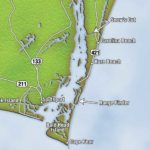
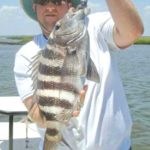
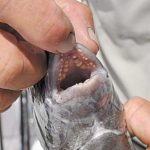
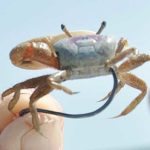
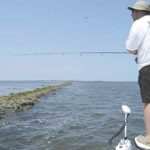
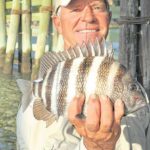
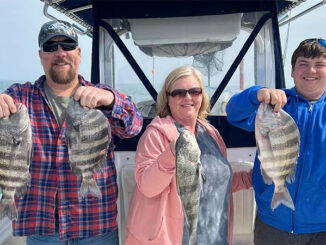



Be the first to comment